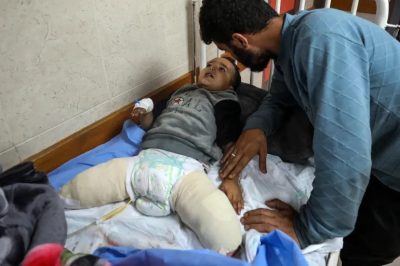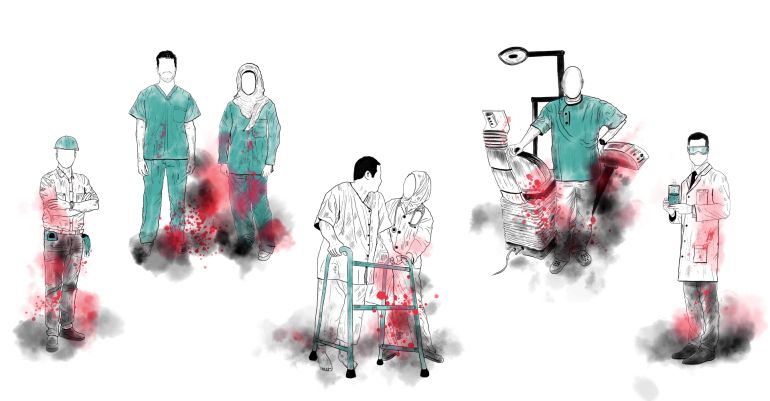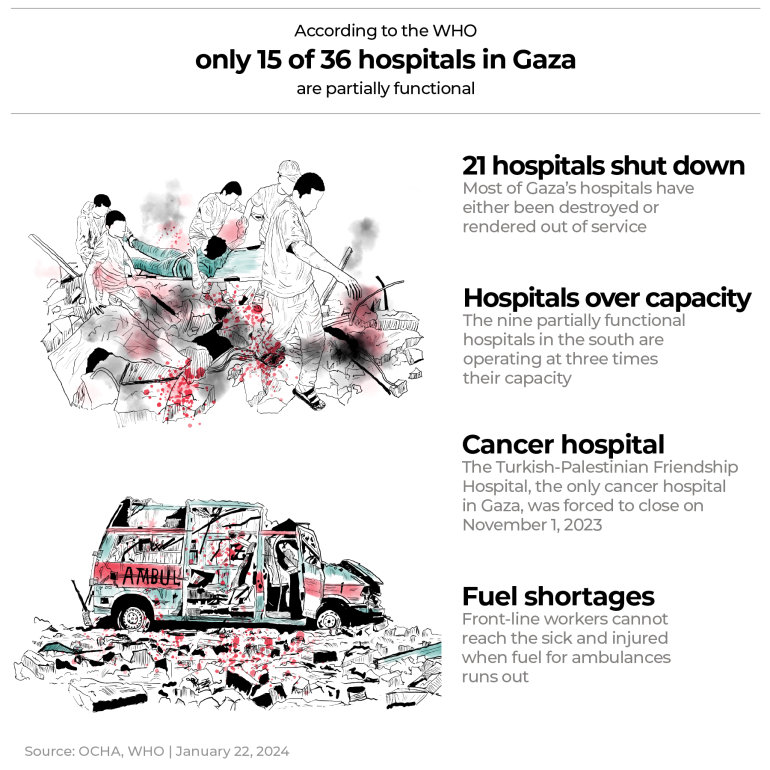Against Every Instinct: How Doctors in Gaza Persevere Amid Israel Attacks

All Global Research articles can be read in 51 languages by activating the Translate Website button below the author’s name (only available in desktop version).
To receive Global Research’s Daily Newsletter (selected articles), click here.
Click the share button above to email/forward this article to your friends and colleagues. Follow us on Instagram and Twitter and subscribe to our Telegram Channel. Feel free to repost and share widely Global Research articles.
New Year Donation Drive: Global Research Is Committed to the “Unspoken Truth”
***
“No doctor wakes up in the morning and says: ‘I’m going to amputate a child’s leg without anaesthesia.’
“You don’t want to watch children suffer,” Dr Amber Alayyan with Doctors Without Borders, known by its French initials MSF, tells Al Jazeera.
The measured cadences of the voice of the charity’s deputy programme manager for Palestine suggests just how inconceivable it is for her, as a doctor and a mother, to cause pain to a patient and to a child.
Yet it is the moral conflict her colleagues in Gaza face daily, minute by minute, as they try to treat unprecedented numbers of injured people flooding into the Gaza Strip’s barely functioning hospitals.
Your natural instinct is to take care of people… to protect people. … You’ve been trained over and over and over and over for years.
As doctors in Gaza are forced to make split-second decisions on who to save and who to let die, on whose pain to relieve and whose they do not have time to, it is that innate instinct and their Hippocratic oath that is assailed by decisions they never thought they’d have to make.
Burdened with personal losses and struggling to operate under unrelenting Israeli bombardments, this is the story of how medical workers are fighting to keep Gaza’s healthcare system going.

How Gaza’s Healthcare System Has Been Destroyed
It is nearing midnight in Gaza and Mohamed S Ziara, a Palestinian doctor, is on a WhatsApp call to Al Jazeera. His tone is soft and unaffected by the rumbling explosions and pop of gunfire that can be heard in the background.
The plastic surgeon is working 12- to 14-hour shifts, six days a week at the European Gaza Hospital (EGH) in Khan Younis, where he treats up to 15 cases a day.
Ziara describes the healthcare situation as “catastrophic”.
“It doesn’t match anything I’ve seen before, even with previous escalations and war,” says Ziara, who has worked during Israel’s assaults on Gaza since 2014.
He has been posting about Israeli attacks near the EGH and the conditions inside on his Instagram account.
The widespread damage caused by Israeli attacks since October 7, following Hamas’s surprise attacks on Israel, has led to a shortage of medical staff and supplies and an urgent need for fuel, electricity and water.
According to the World Health Organization (WHO), only 15 of Gaza’s 36 hospitals are partially functional – nine in the south and six in the north.
From October 7 to November 24, there were 74 Israeli assaults on health facilities with 30 hospitals attacked in Gaza, according to Insecurity Insight, a humanitarian association that collates data on threats facing people in dangerous environments.
Northern Gaza, including Gaza City, has borne the brunt of attacks on the healthcare sector, but as the war has progressed, previously designated safe areas south of Wadi Gaza have come under Israeli fire.
The map below summarises the Israeli attacks on Gaza’s healthcare sector during the first seven weeks of the war.

The hospitals that have been attacked most often include:
- al-Shifa Hospital – attacked 12 times
- al-Quds Hospital – attacked nine times
- Indonesian Hospital – attacked nine times
- Nasser Hospital – attacked three times
Insecurity Insight documented at least 26 other hospitals from across the Gaza Strip that were attacked by Israeli forces over the same period.

These repeated attacks came during an Israeli order on October 13 that instructed all 22 hospitals in northern Gaza to evacuate to the south within 24 hours. The WHO described the order as “impossible to carry out” and “a death sentence for the sick and injured”.
Israel’s Raid on al-Shifa Hospital
One of the first hospitals to come under fire was al-Shifa Hospital, Gaza’s largest medical facility, located in the Remal neighbourhood in Gaza City, where Ziara worked before EGH.
“I remember that I was watching TV, and the spokesman of the [Israeli] army was asked twice about the possibility of bombing the hospital, and he replied that everything is possible,” Ziara says.
Israeli soldiers flanked al-Shifa Hospital on three sides on November 15 and then stormed the complex after Israeli accusations that it was serving as a Hamas command centre.

“We have never seen any military action or military activity inside the hospital,” Ziara says, adding that he thought the threat to the hospital was merely propaganda from the Israeli army. “We never thought that they would reach the hospital and that we’d evacuate patients and the injured.”
Several doctors, including Norwegian Mads Gilbert, who has worked in Gaza for several years, have said they had not seen any evidence of military activity at the hospital during the war.
After the storming of al-Shifa Hospital, a number of United Nations missions were carried out in cooperation with the Palestine Red Crescent Society (PRCS) to evacuate patients and healthcare workers.
The same exercise has been attempted more recently at hospitals in Deir el-Balah in central Gaza and Khan Younis in the south – namely Al-Aqsa, Nasser and EGH – due to ongoing hostilities nearby.
Ziara says he witnessed drone attacks on al-Shifa Hospital.
“They were shooting at people. They injured many. They shot a missile at the hospital garden and killed about four people staying there who had evacuated or were refugees,” he says.
Healthcare Attacks and ‘War Crimes’
Assaults such as those seen on al-Shifa Hospital have raised questions about the legality of attacks on healthcare facilities. International humanitarian law, based on the Geneva Conventions, stipulates that hospitals are considered “civilian objects” and receive de facto protection. Despite that prohibition, Israel has continued to target healthcare structures and workers.
“The UN has been very clear that hospitals, civilians and healthcare workers should be protected, and we continue to call for their protection. They’re not a target,” Dominic Allen, the UN Population Fund’s representative for Palestine, tells Al Jazeera.
Human Rights Watch (HRW) has said attacks on healthcare are “attacks on the sick and the injured”, which need to be “investigated as a war crime”, according to A Kayum Ahmed, special adviser on the right to health at HRW.
According to the UN Office for the Coordination of Humanitarian Affairs (OCHA) and Insecurity Insights, there were at least 212 attacks on healthcare facilities and workers from October 7 to December 11.
The graphic below shows a timeline of all recorded incidents during those nine weeks. Each dot represents a recorded incident and is sized according to the number of casualties.

Targeting Healthcare Workers: ‘He was the kind of guy who would paint your name in bacteria on a Petri dish’
On November 6, Mohammed al-Ahel was in his home in the Shati refugee camp in northern Gaza when Israeli forces bombed the area, collapsing the building he was in.
Al-Ahel was killed along with his two young daughters as well as dozens of other people.
Al-Ahel, who worked as a laboratory technician at Nasser Hospital, was the first of MSF’s staff to be killed in the war.
“He was just such a stereotypical microbiology nerd – the guy that loves the microscope with the big glasses like a real cartoon,” Alayyan says, remembering her colleague. “He was the kind of guy who would paint your name in bacteria on a Petri dish.”
I can’t imagine going back to the lab and not seeing him there. God, he was such a good guy, such an innocent, loving guy.
Al-Ahel left behind a wife and newborn twins. His story is just one of the many shared with Al Jazeera on the personal losses medical staff in Gaza are dealing with. In tandem with the loss of colleagues is also the loss of family members, which forces healthcare workers to operate in unthinkable circumstances where melancholy and resilience coalesce.

According to the Palestinian Ministry of Health, 192 medical personnel were killed from October 7 to November 8:
- 65 nurses
- 29 doctors
- 24 pharmacists
- 20 paramedics
- 17 dentists
- 14 lab technicians
- 11 medical students
- seven physiotherapists
- three medical professors
- one optometrist
- one medical engineer

Since November 8, an additional 182 healthcare personnel have been killed by Israeli forces, bringing the total number killed in Gaza to at least 374 as of January 1, according to a tally by Healthcare Workers Watch – Palestine.
With an average of at least four medical workers being killed every day, hospital staff and paramedics are fighting a dual battle of saving the lives of injured Palestinians while also surviving targeted and indiscriminate attacks.


Operating Under Extreme Conditions: ‘It is scary. We are dealing with these kinds of injuries’
Without proper equipment, sanitation, supplies or even electricity to deal with daily mass casualty events, healthcare workers face a vicious cycle of more people becoming sick due to lack of medicine, space and a sterile clinical environment.
According to the WHO, only 15 of Gaza’s 36 hospitals are partially functional – nine in the south and six in the north. The hospitals in the south are operating at three times their capacity while facing critical shortages of basic supplies and fuel.
The Ministry of Health in Gaza says occupancy rates are reaching 206 percent in inpatient departments and 250 percent in intensive care units.

‘That Loss Can Never be Recovered’
According to Alayyan, MSF has surgical teams at EGH and Nasser Hospital. Another team was operating in the emergency room at Al-Aqsa Martyrs Hospital but had to withdraw on January 6 and 7 after evacuation orders.
“Nasser, Al-Aqsa and EGH are just overwhelmed with mass casualties and trauma surgeries on top of the regular population that needs everyday care. The situation is dire,” Alayyan says.
MSF’s main team also operates from Rafah Field Hospital, where they see 20 to 30 patients daily for postoperative care.
“The problem is that when you’re doing a mass casualty several times a day, every day for three months, your wherewithal runs really low and your threshold for maintaining good practices becomes infinitesimally small,” Alayyan says.
The lack of medical equipment and medicines has led to doctors performing surgeries without anaesthesia or properly sanitised equipment.
“The injuries are so bad, and the psychological impact of that loss can never be recovered,” Ziara says.
“It is so hard to see these kinds of injuries. We’re in a state of shock when we see babies and children who have lost more than a limb in one sitting and then lost many of their family members. It’s so unbearable.”
Trying to Save Limbs
In November, three-year-old Ahmad Shabat lost his legs in an Israeli air strike outside a UN school in the Nuseirat refugee camp. His uncle Ibrahim Abu Amsheh was the only relative at his side in the ICU of Al-Aqsa Martyrs Hospital.

Ahmad Shabat and his uncle Ibrahim at Al-Aqsa Martyrs Hospital in Deir el-Balah in the central Gaza Strip [Atia Darwish/Al Jazeera]
His uncle says Ahmad is not fully aware of what has happened to him.
“He doesn’t know he lost his legs,” the 28-year-old says. “He keeps asking to go outside for a walk.
“He’s in a lot of pain, and the hospital only has Acamol [paracetamol], which you take if you have a headache, not if you’ve lost both your legs.”
The WHO says amputations are carried out despite the possibility of saving limbs because many of the injured cannot reach hospitals due to fighting or there is a lack of specialists, such as vascular surgeons, according to Rik Peeperkorn, the WHO representative for the Palestinian territories.
According to Save the Children, more than 1,000 children have lost one or both their legs since October 7.
Treating Chronic Illnesses the ‘First to Go’
In addition to immediate injuries from Israeli air strikes and artillery, patients with prior and long-term illnesses and vulnerable health conditions are faced with not being treated. According to WHO, they include:
- 1,100 patients in need of kidney dialysis
- 71,000 patients living with diabetes
- 225,000 patients with high blood pressure requiring medication
- 485,000 people with mental health disorders
- cancer patients, 2,000 of whom are diagnosed each year, including 122 children
- 45,000 patients with cardiovascular disease

“I think cancer was one of the first to go because of the care that you need – you need to be in a safe environment, you need to be in a clean environment all the time – and similar for dialysis patients,” Alayyan says.
In addition, an estimated 100 patients a day need access to specialised healthcare outside Gaza. However, due to the precarious nature of evacuations, it is nearly impossible to guarantee the evacuation of some patients, even those approved by the UN with Israeli forces.
Pregnant Women in Gaza ‘Suffer from Thirst and Malnutrition’
There are an estimated 52,000 pregnant women in Gaza with 183 births a day and 5,500 babies being born in the past month, of whom 130 have been premature and dependent on incubators.
Esraa Kamal al-Jamalan was just one of many women faced with the prospect of giving birth in war-torn Gaza. At nearly eight months pregnant, she was forced to flee her home in the northern Gaza neighbourhood of Sheikh Radwan after it was bombed by Israel in late October. She, her husband and their five-year-old son walked more than 3km (nearly 2 miles) to al-Shifa Hospital, where many people were sheltering.
Two months later, 28-year-old Esraa and her family are living in one of the hundreds of makeshift tents in Deir el-Balah in central Gaza. Esraa gave birth to their baby girl at a nearby hospital on November 24 and received stitches without any painkillers. “I begged her [the doctor] to give me a little painkiller,” she says.
According to Allen, who visited Gaza in mid-January, pregnant women at Al-Helal Al-Emairati Maternity Hospital were being rotated in and out of the five delivery rooms due to capacity constraints.
“Women who are in their final stages of labour have to step out of that room to enable another pregnant woman to step in,” he says.
“Many of them suffer from thirst, malnutrition, lack of health. If the bombs don’t kill them, if disease, hunger and dehydration don’t catch up with them, simply giving life will,” Allen says.
![transfer of Shifa Hospital maternity ward to Helou Hospital [Abdelhakim Abu Riash/Al Jazeera]](https://www.aljazeera.com/wp-content/uploads/2023/11/2N8A0503-copy-1699183306.jpg?w=770&quality=80)
Doctors perform a cesarean section on a pregnant woman in Al Helou International Hospital in Gaza City after the maternity ward was transferred from al-Shifa Hospital [Abdelhakim Abu Riash/Al Jazeera]
Alayyan explains that with the war going on for more than three months, the entire third trimester “has been out the window” for many pregnant women who, along with their foetuses, are severely malnourished and stressed.
“You don’t want to force a woman out of a hospital bed with a newborn baby knowing that they’re not going to have any place safe to go. That’s not something you tend to want to do when you sign up to be a paediatrician or an obstetrician or a nurse. You want to hold people’s hands. You want to help them enjoy that moment,” Alayyan says.
What Lies Ahead for Gaza’s Healthcare System?
On January 7, exactly three months into the war on Gaza, WHO Director-General Tedros Adhanom Ghebreyesus said: “It is inconceivable that this most essential need – the protection of healthcare – is not assured.”
Dr Tanya Haj-Hassan with MSF echoed these comments, telling Al Jazeera that there is an urgent need for a ceasefire. With no fully functioning hospitals in Gaza and a number of WHO missions cancelled due to a lack of permission and security, healthcare facilities are hanging on by a thread.
Recently at Al-Aqsa Martyrs Hospital, WHO staff described scenes of chaos and “people of all ages being treated on blood-streaked floors”.
“My biggest concern is what’s going to happen with vaccine-preventable diseases,” Alayyan says. “And my concern is that for the children who have been born in the last three to six months, they’re not going to be protected, and I think that what we’re going to see in a few months are huge epidemics, and we’re already seeing people who are getting sick and potentially dying of the infections as a result of their injuries.”
Ziara, who never thought he’d have to amputate children’s legs without anaesthetic, remembers what his colleagues said at the start of the war.
Concern can be heard in his voice as gunfire draws closer. It’s now almost midnight, and our phone conversation is cut short because it’s no longer safe to talk. But he still has time to say thank you.
*
Note to readers: Please click the share button above. Follow us on Instagram and Twitter and subscribe to our Telegram Channel. Feel free to repost and share widely Global Research articles.
Featured image: Ahmad Shabat and his uncle Ibrahim at Al-Aqsa Martyrs Hospital in Deir el-Balah in the central Gaza Strip [Atia Darwish/Al Jazeera]

